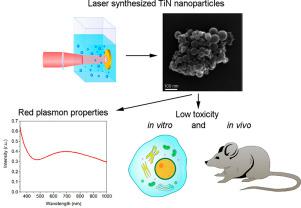Biomaterials Advances ( IF 5.5 ) Pub Date : 2020-11-27 , DOI: 10.1016/j.msec.2020.111717 Ivan V. Zelepukin , Anton A. Popov , Victoria O. Shipunova , Gleb V. Tikhonowski , Aziz B. Mirkasymov , Elena A. Popova-Kuznetsova , Sergey M. Klimentov , Andrei V. Kabashin , Sergey M. Deyev

|
Having plasmonic absorption within the biological transparency window, titanium nitride (TiN) nanoparticles (NPs) can potentially outperform gold counterparts in phototheranostic applications, but characteristics of available TiN NPs are still far from required parameters. Recently emerged laser-ablative synthesis opens up opportunities to match these parameters as it makes possible the production of ultrapure low size-dispersed spherical TiN NPs, capable of generating a strong phototherapy effect under 750–800 nm excitation. This study presents the first assessment of toxicity, biodistribution and pharmacokinetics of laser-synthesized TiN NPs. Tests in vitro using 8 cell lines from different tissues evidenced safety of both as-synthesized and PEG-coated NPs (TiN-PEG NPs). After systemic administration in mice, they mainly accumulated in liver and spleen, but did not cause any sign of toxicity or organ damage up to concentration of 6 mg kg−1, which was confirmed by the invariability of blood biochemical parameters, weight and hemotoxicity examination. The NPs demonstrated efficient passive accumulation in EMT6/P mammary tumor, while concentration of TiN-PEG NPs was 2.2-fold higher due to “stealth” effect yielding 7-times longer circulation in blood. The obtained results evidence high safety of laser-synthesized TiN NPs for biological systems, which promises a major advancement of phototheranostic modalities on their basis.
中文翻译:

用于生物医学应用的激光合成TiN纳米颗粒:安全性,生物分布和药代动力学评估
氮化钛(TiN)纳米颗粒(NPs)在生物透明性窗口内具有等离子体吸收,在光热学应用中可能会优于金纳米颗粒,但是可用的TiN NPs的特性仍远非必需的参数。最近出现的激光烧蚀合成技术为匹配这些参数开辟了机会,因为它可以生产超纯的低尺寸分散的球形TiN NP,并能在750-800 nm激发下产生强大的光疗效果。这项研究提出了激光合成的TiN NPs的毒性,生物分布和药代动力学的首次评估。使用来自不同组织的8种细胞系进行的体外测试证明了合成的和PEG包覆的NP(TiN-PEG NP)的安全性。对小鼠进行全身给药后,-1,由血液生化参数,体重和血液毒性检查的不变性所证实。NPs在EMT6 / P乳腺肿瘤中表现出有效的被动积累,而TiN-PEG NPs的浓度由于“隐身”效应而产生的血液循环时间延长了7倍,因此高2.2倍。所获得的结果证明了激光合成的TiN NP在生物系统中的高度安全性,这有望在其基础上显着提高光热学模态。











































 京公网安备 11010802027423号
京公网安备 11010802027423号